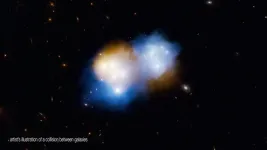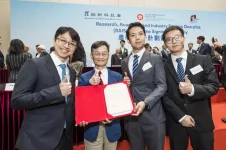(Press-News.org) Reston, VA—The Journal of Nuclear Medicine (JNM)—the flagship publication of the Society of Nuclear Medicine and Molecular Imaging—has maintained its status as one of the top medical imaging journals worldwide, according to new data just released in Clarivate's 2023 Journal Citation Reports. With an impact factor of 9.1, JNM saw increases in its five-year impact factor, journal citation indicator, and article influence score, among other categories.
“This is an exciting time for nuclear medicine, with ground-breaking advances in molecular imaging, theranostics, artificial intelligence, and other areas,” said Johannes Czernin, MD, JNM editor-in-chief and professor of molecular and medical pharmacology and chief of the Ahmanson Translational Theranostics Division at the UCLA David Geffen School of Medicine, Los Angeles, California.
Of 204 medical imaging journals included in the Clarivate report, JNM ranked sixth overall. JNM’s journal citation indicator (JCI) achieved its highest rating to date, jumping from 2.59 to 2.98 percent. The JCI is a single score given to each journal based on normalized citations across three full years of citation data. As average performance is set to 1.0, JNM’s JCI rating of 2.98 percent means the journal performed close to three times better than average. In addition, the journal’s five-year impact factor increased from 9.0 to 9.1, and the article influence score rose from 2.257 to 2.606. The normalized Eigenfactor score also increased from 5.7023 to 6.11.
“The JNM editorial team is very intentional in the articles that it chooses for publication in the journal,” notes Czernin. “By keeping our pulse on advances in the field and adhering to rigorous quality standards, we strive to make the journal an invaluable resource for the nuclear medicine and molecular imaging field. I applaud the entire team, from the associate editors and reviewers to SNMMI Publications Committee to journal staff for their contributions to JNM.”
Visit the JNM website for the latest research, and follow our new Twitter and Facebook pages @JournalofNucMed or follow us on LinkedIn.
Please visit the SNMMI Media Center for more information about molecular imaging and precision imaging. To schedule an interview with the researchers, please contact Rebecca Maxey at (703) 652-6772 or rmaxey@snmmi.org.
###
About JNM and the Society of Nuclear Medicine and Molecular Imaging
The Journal of Nuclear Medicine (JNM) is the world’s leading nuclear medicine, molecular imaging and theranostics journal, accessed more than 16 million times each year by practitioners around the globe, providing them with the information they need to advance this rapidly expanding field. Current and past issues of The Journal of Nuclear Medicine can be found online at http://jnm.snmjournals.org.
JNM is published by the Society of Nuclear Medicine and Molecular Imaging (SNMMI), an international scientific and medical organization dedicated to advancing nuclear medicine and molecular imaging—precision medicine that allows diagnosis and treatment to be tailored to individual patients in order to achieve the best possible outcomes. For more information, visit www.snmmi.org.
END
JNM maintains strong metrics in 2023 Journal Citation Reports
2024-07-24
ELSE PRESS RELEASES FROM THIS DATE:
New study determines incidence of and risk factors for hepatitis C virus reinfection among men with HIV, offers new insight on transmission
2024-07-24
Paper Title: Hepatitis C Virus Reinfection Among Men Who Have Sex With Men With HIV in New York City
Journal: Clinical Infectious Diseases, July 2024
Authors: Daniel S. Fierer, MD, Professor of Medicine (Infectious Diseases) at the Icahn School of Medicine at Mount Sinai, and other coauthors.
Bottom Line: This study provides new perspectives on transmission of hepatitis C virus (HCV), a virus that infects the liver and can be transmitted during injection of drugs, among men who have sex with men (MSM).
How: The researchers performed a prospective cohort study in New York City of MSM with HIV who had cleared ...
Dark matter flies ahead of normal matter in mega galaxy cluster collision
2024-07-24
Astronomers have untangled a messy collision between two massive clusters of galaxies in which the clusters' vast clouds of dark matter have decoupled from the so-called normal matter. The two clusters each contain thousands of galaxies and are located billions of light-years away from Earth. As they plowed through each other, the dark matter—an invisible substance that feels the force of gravity but emits no light—sped ahead of the normal matter. The new observations are the first to directly probe the decoupling of the dark and normal matter velocities.
Galaxy ...
Lyda Hill Philanthropies funds innovative wildfire solutions in Colorado
2024-07-24
Lyda Hill Philanthropies has donated $290,000 to Cary Institute of Ecosystem Studies for the Western Fire & Forest Resilience Collaborative. The two-year grant will help to engage a research team within the Collaborative that is focused on wildfire-related challenges and solutions in Colorado, where Lyda Hill has deep family ties.
Led by Winslow Hansen at Cary Institute and launched with seed funding from the Gordon and Betty Moore Foundation, the Western Fire & Forest Resilience Collaborative joins together multidisciplinary ...
Increasing cardiac ketones may help heart failure in mouse study
2024-07-24
Research Highlights:
In mice with heart failure with preserved ejection fraction (HFpEF), increasing ketone supply to the heart allowed their hearts to utilize more ketones and produce more energy.
Researchers hope this study may help to improve our understanding of the complex and different root causes of HFpEF from a metabolic perspective and potentially identify targets for development of medications to treat HFpEF.
Note: The study featured in this news release is a research abstract. Abstracts ...
Toward a quantum electron microscope: a compact pulse hollow cone hybrid TEM/SEM by CityUHK to revolutionize electron microscopy
2024-07-24
Electron microscopes have long been indispensable tools in scientific research, offering unparalleled resolution and magnification capabilities. However, current electron microscopy technologies face significant limitations, including high cost, large size, strong radiation damage to samples through interaction with the electron beam, and the need for cryogenic temperatures. A research team from City University of Hong Kong (CityUHK) is working on a new quantum electron microscope (QEM) to eliminate interaction between the electron beam and sample. At this stage, the team is using partial key components of QEM ...
New study confirms mammal-to-mammal avian flu spread
2024-07-24
ITHACA, N.Y. – A new Cornell University study provides evidence that a spillover of avian influenza from birds to dairy cattle across several U.S. states has now led to mammal-to-mammal transmission – between cows and from cows to cats and a raccoon.
“This is one of the first times that we are seeing evidence of efficient and sustained mammalian-to-mammalian transmission of highly pathogenic avian influenza H5N1,” said Diego Diel, associate professor of virology and director of the Virology Laboratory at the Animal Health Diagnostic ...
MD Anderson Research Highlights for July 24, 2024
2024-07-24
HOUSTON ― The University of Texas MD Anderson Cancer Center’s Research Highlights showcases the latest breakthroughs in cancer care, research and prevention. These advances are made possible through seamless collaboration between MD Anderson’s world-leading clinicians and scientists, bringing discoveries from the lab to the clinic and back.
Recent developments at MD Anderson include low-dose radiation for B-cell lymphoma, a target for overcoming treatment resistance in pancreatic cancer, decreased public trust in U.S. health agencies providing cancer information, ...
Building a molecular brain map to understand Alzheimer’s disease
2024-07-24
Less than a decade ago, when Dr. Hansruedi Mathys launched an ambitious project to create an annotated library of all the gene readouts stored within 100 individual brain cells, the task felt daunting.
Now, with technological advances, Mathys successfully mapped out such ‘transcriptomes’ from not just 100, but from 1.3 million brain cortex cells from 48 individuals with and without Alzheimer’s disease.
Mathys, who pioneered single-cell transcriptomic analysis on post-mortem human brain tissue during his postdoctoral training and is now an assistant professor of neurobiology at the University of Pittsburgh School of Medicine, says that the resulting ...
Trees reveal climate surprise – bark removes methane from the atmosphere
2024-07-24
Tree bark surfaces play an important role in removing methane gas from the atmosphere, according to a study published today (24 July) in Nature.
While trees have long been known to benefit climate by removing carbon dioxide from the atmosphere, this new research reveals a surprising additional climate benefit. Microbes hidden within tree bark can absorb methane – a powerful greenhouse gas – from the atmosphere.
An international team of researchers led by the University of Birmingham has shown for ...
Webb images nearest super-Jupiter, opening a new window to exoplanet research
2024-07-24
“We were excited when we realised we had imaged this new planet”, said Elisabeth Matthews, a researcher at the Max Planck Institute for Astronomy in Heidelberg, Germany. She is the main author of the underlying research article published in the journal Nature. “To our surprise, the bright spot that appeared in our MIRI images did not match the position we were expecting for the planet”, Matthews points out. “Previous studies had correctly identified a planet in this system but underestimated this super-Jupiter gas giant’s ...




